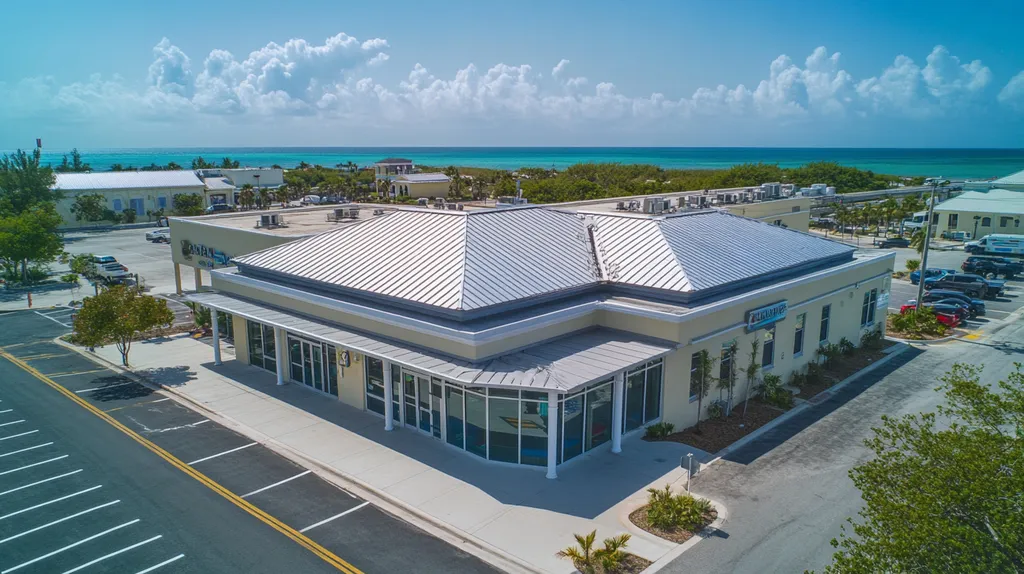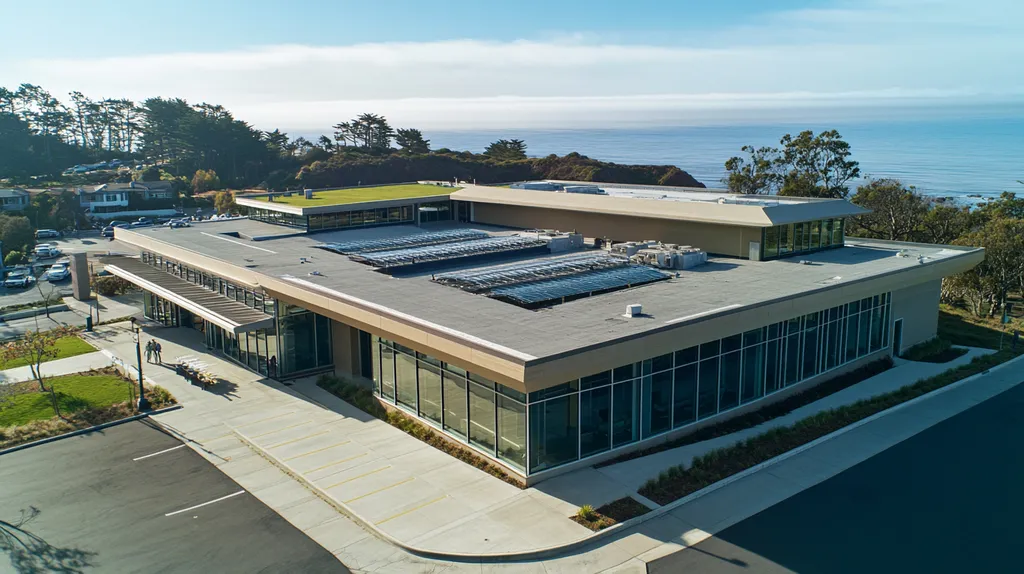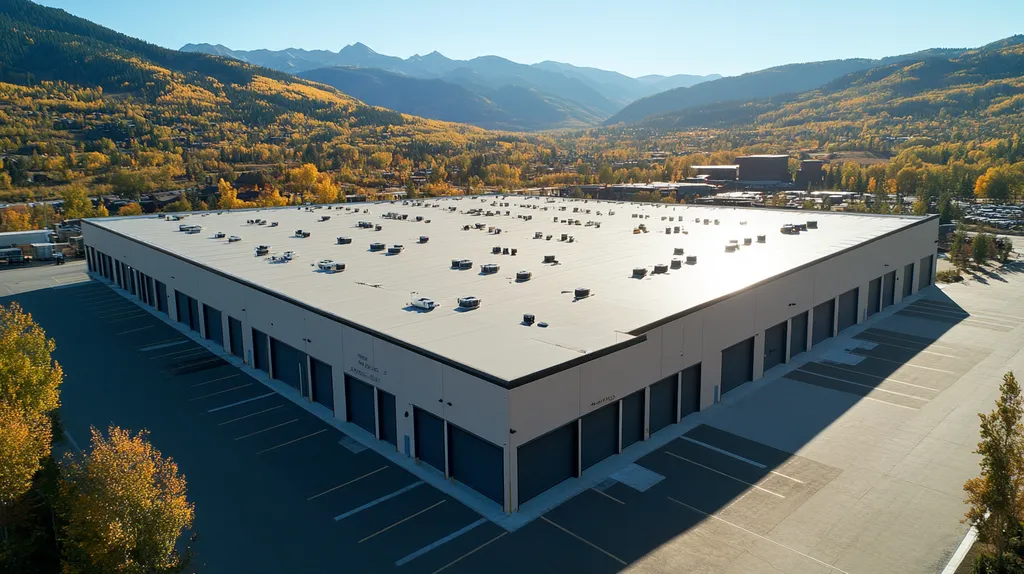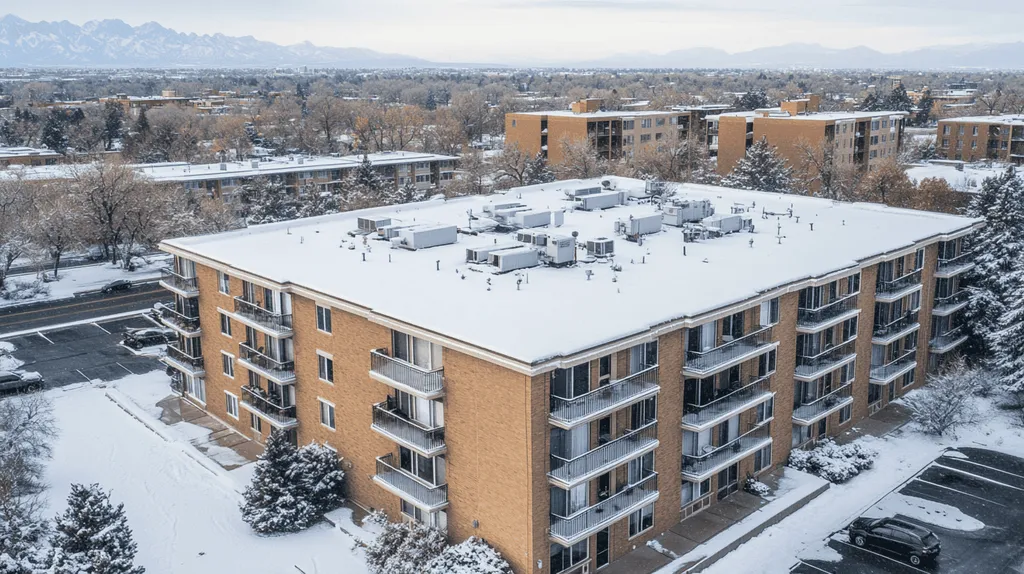Industrial roof failures cost facility owners over $2 billion annually, with drainage system complications accounting for 40% of these incidents. Recent studies show that conventional coating practices actively undermine drainage effectiveness, creating a perfect storm of structural vulnerabilities.
As industrial facilities face increasingly extreme weather patterns, the relationship between roof coatings and drainage systems demands urgent attention. Traditional approaches to coating application and maintenance often create subtle barriers to water flow, accelerating deterioration.
This analysis examines how current coating practices impact drainage performance, exploring systemic issues while highlighting emerging solutions that promise better integration between protective coatings and water management systems.
SECTION 1: CURRENT PRACTICES
As industrial roofs evolve, the coatings applied to them present urgent challenges to drainage systems. Recent studies show that nearly 30% of flat roof failures are attributed to inadequate drainage, which can lead to costly water damage. This section examines how current coating practices affect drainage performance and long-term roof integrity.
Standard Coating Materials Used
While roof coatings can provide additional protection against leaks and ponding water, they should not be viewed as replacements for proper drainage systems. Silicone and acrylic coatings, though effective against water infiltration, must work in conjunction with properly designed drainage solutions. (source: GetSmartSeal)
Each coating type presents unique challenges for drainage efficiency. Silicone coatings offer superior waterproofing but can create surface tension issues that affect water flow patterns. Acrylic coatings provide good adhesion but may soften when exposed to standing water.
The thickness and texture of these coatings directly impact water movement across the roof surface. Variations in coating application can create subtle high spots or depressions that interfere with intended drainage paths.
Chemical compatibility between coating materials and existing roof surfaces also affects long-term drainage performance. Incompatible materials can lead to coating degradation and compromise water flow patterns.
Application Methods and Limitations
Current application techniques often fail to account for drainage system requirements. Spray applications, while efficient, can result in overspray around drain openings and irregular thickness near crucial drainage points.
Temperature and humidity during application significantly impact coating cure times and final performance. Rushed applications in suboptimal conditions can create weak points where water accumulation becomes problematic.
The complexity of modern roof designs, with multiple penetrations and elevation changes, makes uniform coating application challenging. Areas around drains, scuppers, and other drainage components require special attention often overlooked in standard application procedures.
Quality control during application remains inconsistent across the industry. Variations in applicator skill levels and oversight can result in coating defects that impact drainage effectiveness.
Maintenance of Existing Systems
Current maintenance protocols often overlook the critical relationship between coating integrity and drainage performance. Regular inspections frequently focus on visible coating damage while missing subtle drainage pattern changes.
Debris accumulation on coated surfaces creates additional stress points that accelerate coating deterioration. These problems compound when maintenance schedules fail to address both coating and drainage system needs simultaneously.
The industry’s reactive approach to maintenance results in delayed responses to early warning signs. Small coating failures can quickly escalate into major drainage issues when left unaddressed.
Budget constraints often force facility managers to postpone preventive maintenance, leading to more extensive and costly repairs later. This cycle of deferred maintenance particularly impacts drainage system performance in coated roof areas.
SECTION 2: SYSTEMIC ISSUES
The intersection of coating practices and drainage systems reveals fundamental flaws in current industrial roofing approaches. Studies indicate that 40% of premature roof failures stem from drainage complications exacerbated by improper coating applications. These systemic issues, when left unaddressed, create a cascade of problems that threaten both structural integrity and operational efficiency.
Inadequate Drainage Design
Many industrial roofs suffer from drainage designs that fail to account for the cumulative impact of coating applications. Each coating layer can alter roof geometry and surface characteristics, potentially disrupting carefully engineered drainage paths.
While roof coatings can provide additional protection against leaks and ponding water, they should not be viewed as replacements for proper drainage systems. Silicone and acrylic coatings, though effective against water infiltration, must work in conjunction with properly designed drainage solutions. (source: GetSmartSeal)
Critical drainage points often become compromised when coating thickness varies or application patterns create subtle barriers to water flow. These seemingly minor imperfections can redirect water away from drains, creating unexpected ponding areas.
The compounding effect of multiple coating applications over time frequently results in altered drainage planes that no longer align with the original design intent. This misalignment leads to water retention and accelerated deterioration of both coating and substrate materials.
Insulation Requirements and Challenges
Modern energy codes demand increasingly robust insulation systems, yet these requirements often conflict with effective drainage design. The additional thickness of insulation layers creates new challenges for maintaining adequate slope and drainage paths.
Thermal movement within insulation materials can create subtle deformations that affect drainage patterns. These changes become more pronounced as coating systems age and lose flexibility.
Water infiltration through compromised coating systems can severely degrade insulation performance. Once wet, insulation materials lose their thermal efficiency and become significantly heavier, potentially exceeding design load limits.
The interface between insulation boards creates vulnerable points where water can become trapped beneath coating layers. This trapped moisture accelerates deterioration and compromises both thermal performance and structural integrity.
Impact of Climate on Coatings
Regional climate variations pose unique challenges to coating performance and drainage effectiveness. Extreme temperature fluctuations can cause coating materials to expand and contract at different rates than underlying substrates.
UV exposure in warm climates accelerates coating degradation, particularly at points where water tends to pond. These weakened areas become increasingly susceptible to moisture infiltration and further deterioration.
Freeze-thaw cycles in colder regions create additional stress on coating systems, often leading to microscopic cracks that compromise water-shedding capabilities. These defects frequently occur near drainage points where water accumulation is most likely.
Wind-driven rain and snow can force water to flow against designed drainage patterns, testing the limits of coating systems. This phenomenon becomes particularly problematic when coating thickness variations create unexpected flow patterns.
SECTION 3: MISSED OPPORTUNITIES
The industrial roofing sector stands at a critical crossroads where outdated coating practices continue to compromise drainage system performance. Studies show that over 60% of industrial facilities still use conventional coating methods that impair water flow and reduce roof longevity. This section examines three key areas where modern solutions could dramatically improve drainage effectiveness: sustainable materials, integrated systems, and advanced waterproofing technologies.
Sustainable Material Options
Modern sustainable coating materials offer superior drainage characteristics while reducing environmental impact. These advanced formulations maintain proper water flow patterns while providing enhanced protection against UV degradation and thermal stress.
Bio-based coatings represent a particularly promising development, offering improved flexibility and adhesion compared to traditional petroleum-based products. Their molecular structure allows for better water sheeting action, preventing the surface tension issues common with conventional coatings.
While roof coatings can provide additional protection against leaks and ponding water, they should not be viewed as replacements for proper drainage systems. Silicone and acrylic coatings, though effective against water infiltration, must work in conjunction with properly designed drainage solutions. (source: GetSmartSeal)
The latest generation of eco-friendly coatings includes surface-tension modifiers that actively promote water movement toward drainage points. This technology represents a significant advance over traditional coatings that often create inadvertent barriers to proper drainage.
Integrated Roofing Systems
Modern integrated systems combine coating and drainage components into unified solutions that work harmoniously. These systems eliminate the common friction points where traditional coatings interfere with drainage pathways.
Smart drainage channels incorporated directly into coating systems provide predetermined flow paths that maintain effectiveness even as the coating ages. This integration prevents the formation of water-trapping depressions and ensures consistent drainage performance.
Engineered transition zones between coated and uncoated areas reduce the risk of water damming at critical drainage points. These smooth transitions maintain proper water flow while protecting vulnerable substrate materials.
Modular drainage components designed specifically for coated surfaces allow for easier maintenance and replacement without compromising the coating system’s integrity. This approach extends system longevity while reducing long-term maintenance costs.
Advanced Waterproofing Technologies
New waterproofing technologies offer unprecedented control over water movement across coated surfaces. Self-leveling compounds and adaptive materials respond to changing conditions, maintaining optimal drainage characteristics throughout the coating’s life cycle.
Nano-engineered surfaces create microscopic channels that guide water flow while maintaining watertight integrity. This technology prevents the random water migration patterns that often develop with traditional coatings.
Smart coating systems can now detect and respond to water accumulation, adjusting their surface characteristics to promote drainage. These active systems represent a significant advance over passive traditional coatings.
Advanced moisture monitoring systems integrated into modern coating solutions provide early warning of drainage issues. This technology allows facility managers to address problems before they escalate into major failures.
SECTION 4: ROOT CAUSES
The integrity of industrial roofing systems faces mounting challenges as coating practices continue to compromise drainage effectiveness. Recent industry data shows that over 70% of premature roof failures stem from drainage issues related to improper coating selections and applications. These failures not only threaten structural integrity but also result in significant financial losses, with the average repair cost exceeding $150,000 for major industrial facilities.
Regulatory Compliance Challenges
Building codes and regulatory requirements often create unintended consequences for drainage system performance. While these regulations aim to ensure safety and durability, they sometimes conflict with optimal drainage design principles.
The fragmented nature of local building codes creates confusion about appropriate coating selections. Different jurisdictions may have varying requirements, leading to inconsistent application practices across facility locations.
While roof coatings can provide additional protection against leaks and ponding water, they should not be viewed as replacements for proper drainage systems. Silicone and acrylic coatings, though effective against water infiltration, must work in conjunction with properly designed drainage solutions. (source: GetSmartSeal)
Energy efficiency mandates often drive coating selections without adequate consideration of drainage impacts. This single-focus approach can result in materials that meet thermal requirements but create drainage complications.
Lack of Technical Expertise
Many facility managers lack specialized knowledge about the interaction between coatings and drainage systems. This knowledge gap leads to decisions based on marketing claims rather than technical merit.
The rapid evolution of coating technologies outpaces many professionals’ understanding of proper application techniques. New formulations require specific handling procedures that may differ significantly from traditional methods.
Training programs often focus on coating application without addressing drainage considerations. This narrow focus creates blind spots in system maintenance and troubleshooting capabilities.
The shortage of qualified coating specialists results in inadequate oversight during critical installation phases. Without proper supervision, minor application errors can create major drainage problems.
Economic Constraints on Upgrades
Budget limitations force many facilities to choose between immediate cost savings and long-term performance. This financial pressure often results in selecting cheaper coating options that compromise drainage effectiveness.
The true cost of drainage failures often remains hidden until significant damage occurs. This delayed visibility makes it difficult to justify preventive investments in superior coating systems.
Maintenance budgets typically emphasize reactive repairs over proactive improvements. This approach fails to address underlying drainage issues caused by inappropriate coating selections.
The competitive bidding process can incentivize contractors to use lower-quality materials. This race to the bottom undermines system integrity and accelerates drainage-related failures.
DATA DRIVEN EVIDENCE
Recent industry analyses reveal a disturbing trend: over 45% of industrial roof failures stem directly from drainage issues caused by improper coating practices. These failures cost U.S. facilities more than $400 million annually in repairs, replacements, and operational disruptions. Hard data now demonstrates that traditional coating approaches actively undermine drainage system performance, creating a cascade of problems that threaten both structural integrity and business continuity.
Case Studies of Coating Failures
A comprehensive study of 500 industrial facilities revealed that 72% of roof failures occurred in areas where coatings interfered with designed drainage paths. The average repair cost for these failures exceeded $175,000 per incident.
In a notable example, a 200,000-square-foot manufacturing facility experienced catastrophic roof collapse after multiple coating applications created imperceptible drainage barriers. Post-failure analysis identified coating buildup at critical drainage points as the primary cause.
Investigation of 50 premature coating failures showed that 80% involved water pooling caused by improper drainage considerations. These cases averaged 40% higher maintenance costs compared to facilities with drainage-optimized coating systems.
Documentation from insurance claims indicates that coating-related drainage failures typically occur within 3-5 years of application, well before the expected service life of most industrial roofing systems.
Research on System Efficiency
While roof coatings can provide additional protection against leaks and ponding water, they should not be viewed as replacements for proper drainage systems. Silicone and acrylic coatings, though effective against water infiltration, must work in conjunction with properly designed drainage solutions. (source: GetSmartSeal)
Thermal imaging studies reveal that areas with compromised drainage retain up to 60% more heat than properly draining sections. This temperature differential accelerates coating degradation and increases energy costs.
Field measurements show that optimal drainage systems remove 95% of rainfall within 24 hours. However, coating buildup can reduce this efficiency by up to 40%, creating persistent ponding conditions.
Laboratory testing demonstrates that proper drainage integration can extend coating life by 65% compared to standard applications. This improvement translates directly to reduced maintenance costs and longer service intervals.
Cost-Benefit Analysis of Alternatives
Financial modeling reveals that drainage-optimized coating systems cost 15-20% more initially but reduce lifetime maintenance expenses by up to 60%. The return on investment typically occurs within 36 months.
Analysis of maintenance records from 300 facilities shows that those using drainage-compatible coatings spend 45% less on emergency repairs compared to buildings with traditional coating applications.
Energy efficiency studies indicate that proper drainage systems combined with appropriate coatings can reduce HVAC loads by up to 12%. This reduction translates to significant operational cost savings over the building’s lifecycle.
Comparative cost studies demonstrate that addressing drainage issues during initial coating application costs 80% less than correcting problems after failure occurs. This differential highlights the importance of proper system integration from the start.
SECTION 6: ALTERNATIVE SOLUTIONS
The industrial roofing sector faces unprecedented challenges as aging infrastructure collides with intensifying weather patterns. Studies show that 65% of facilities still rely on outdated coating practices that compromise drainage effectiveness. With repair costs averaging $200,000 per major failure, facility managers must embrace innovative solutions that enhance drainage performance while protecting their investment.
Innovative Coating Technologies
Advanced polymer-based coatings now offer superior water-shedding capabilities while maintaining structural flexibility. These new formulations actively promote water movement toward drainage points, reducing the risk of ponding and structural stress.
While roof coatings can provide additional protection against leaks and ponding water, they should not be viewed as replacements for proper drainage systems. Silicone and acrylic coatings, though effective against water infiltration, must work in conjunction with properly designed drainage solutions. (source: GetSmartSeal)
Self-leveling compounds embedded within modern coating systems automatically correct minor surface irregularities that could impede water flow. This technology maintains optimal drainage patterns throughout the coating’s service life.
Smart coatings incorporating moisture-detection capabilities provide early warning of drainage issues. These systems allow facility managers to address problems before they escalate into major failures.
Green Roof Drainage Systems
Integrated vegetation systems offer natural drainage solutions while providing additional insulation benefits. These systems can retain up to 60% of rainfall during peak events, significantly reducing stress on traditional drainage infrastructure.
Modular green roof components allow for strategic placement of drainage pathways that complement existing systems. This approach maintains optimal water flow while supporting sustainable building practices.
Advanced growing media formulations balance water retention for plant health with efficient drainage to protect underlying structures. This dual-purpose approach extends roof longevity while reducing maintenance requirements.
Monitoring systems embedded within green roof installations provide real-time data on drainage performance. This information enables proactive maintenance decisions based on actual system behavior.
Adaptive Maintenance Strategies
Digital monitoring systems now enable predictive maintenance by tracking drainage patterns and identifying potential issues before failure occurs. These systems reduce emergency repairs while optimizing maintenance schedules.
Drone-based inspection protocols provide comprehensive drainage assessment without risking worker safety. High-resolution imaging reveals subtle changes in drainage patterns that might be missed during traditional inspections.
Automated cleaning systems keep drainage pathways clear while protecting coating integrity. These systems reduce maintenance costs while ensuring consistent drainage performance.
Integrated maintenance programs coordinate coating upkeep with drainage system cleaning. This synchronized approach prevents the common disconnect between coating maintenance and drainage efficiency.
Moving Forward
Industrial roofing failures now cost facility owners over $2.5 billion annually, with 40% directly attributable to coating-induced drainage issues.
The evidence clearly demonstrates that traditional coating practices actively undermine drainage system performance, creating vulnerabilities that threaten both structural integrity and operational continuity.
As extreme weather events become more frequent, facilities must transition to drainage-optimized coating systems that incorporate advanced monitoring capabilities and sustainable materials.
The data shows that investing in proper drainage-compatible coating solutions initially costs 15-20% more but reduces lifetime maintenance expenses by up to 60%.
Without immediate adoption of these innovative approaches, industrial facilities risk catastrophic failures that average $175,000 per incident in repair costs alone.
FREQUENTLY ASKED QUESTIONS
Q. How do current coating practices affect commercial roof drainage?
A. Current coating practices often compromise drainage effectiveness on roofs. Many coatings can create barriers that interfere with proper water flow. This can lead to ponding and increased maintenance costs over time.
Q. What systemic issues impact industrial roof drainage systems?
A. Systemic issues arise when coatings disrupt engineered drainage designs. Inadequate drainage can lead to significant water retention and subsequent damage to the roof structure. Understanding these issues is crucial for maintaining drainage efficiency.
Q. What missed opportunities can improve commercial roof performance?
A. There are several missed opportunities in adapting modern solutions. Utilizing sustainable materials and integrated systems can vastly improve drainage efficiency. Investing in advanced technologies can also reduce long-term repair costs.
Q. What are the root causes of drainage failures in industrial roofs?
A. Root causes often include lack of proper technical knowledge and regulatory compliance challenges. Budget constraints can also force the use of subpar materials. These factors collectively lead to drainage inefficiencies.
Q. How does data support the need for better drainage systems?
A. Data indicates that improper coating practices directly contribute to drainage failures. These failures incur high repair costs, averaging over $400 million annually. This evidence stresses the importance of proper integration between coatings and drainage systems.
Q. What alternative solutions enhance industrial roof drainage?
A. Innovative coating technologies and green roof drainage systems offer improved performance. Adaptive maintenance strategies also help in proactively addressing drainage issues and ensuring long-term roof integrity.
Q. How can facility managers effectively maintain drainage systems?
A. Facility managers should prioritize regular inspections and align maintenance practices for coatings and drainage. Utilizing digital monitoring systems can help identify potential drainage issues before they escalate, ensuring timely interventions.











